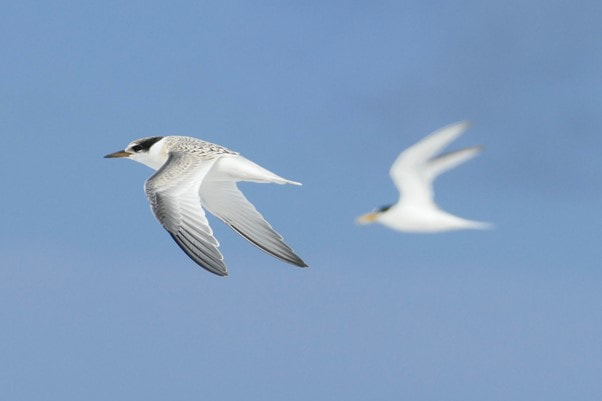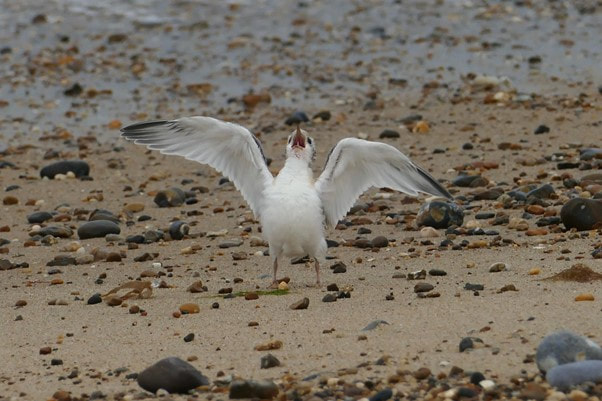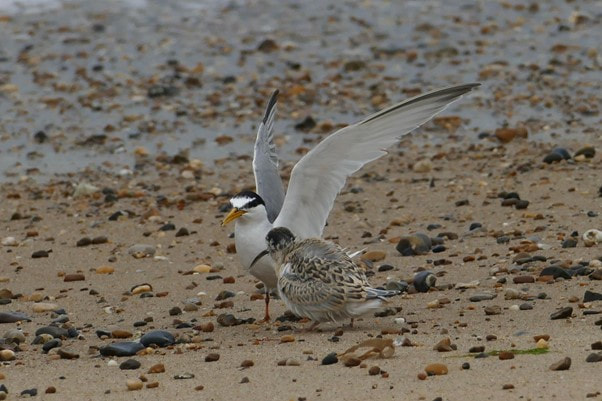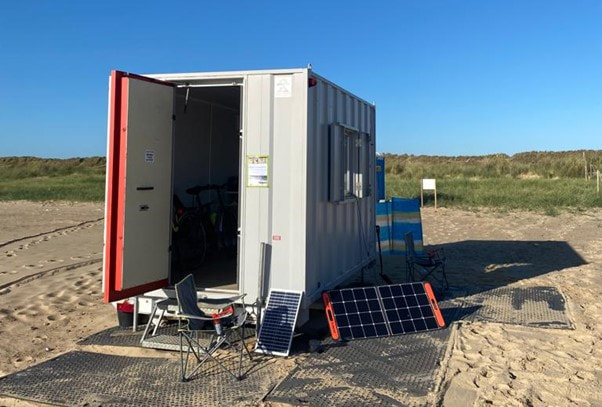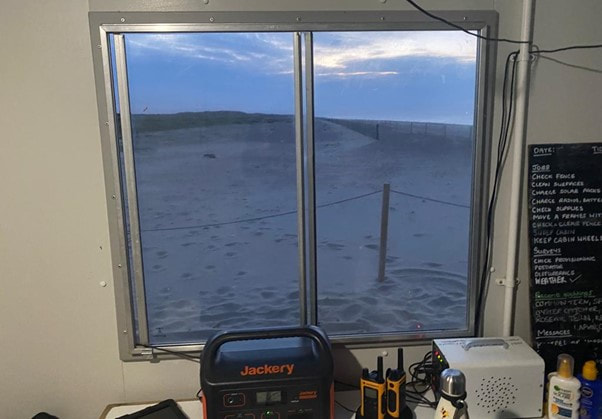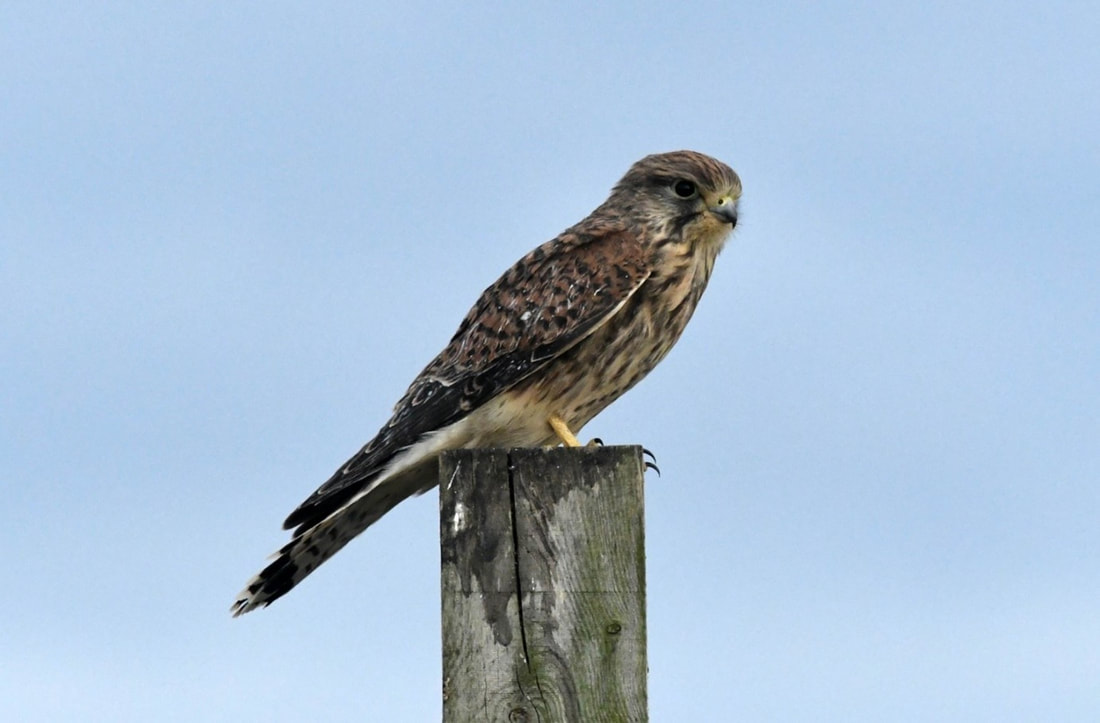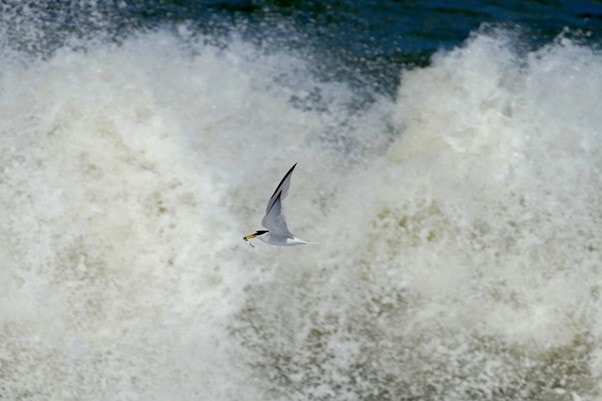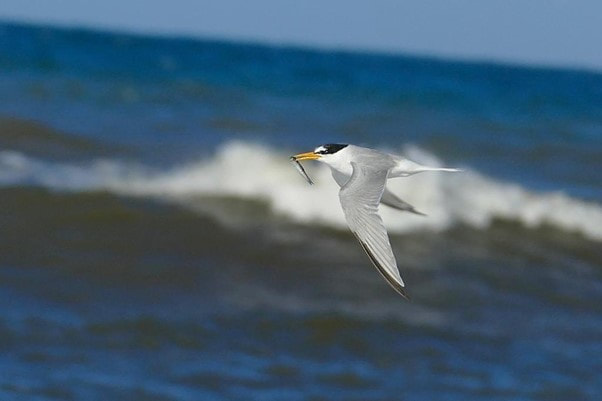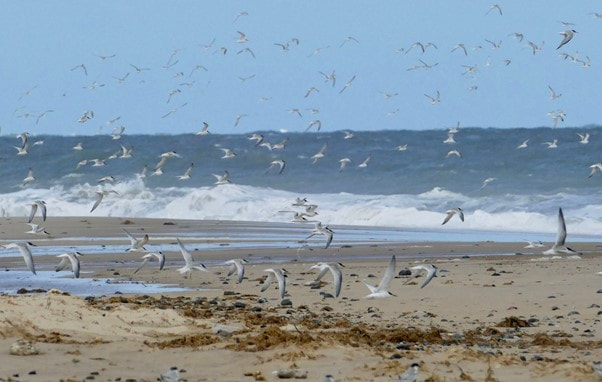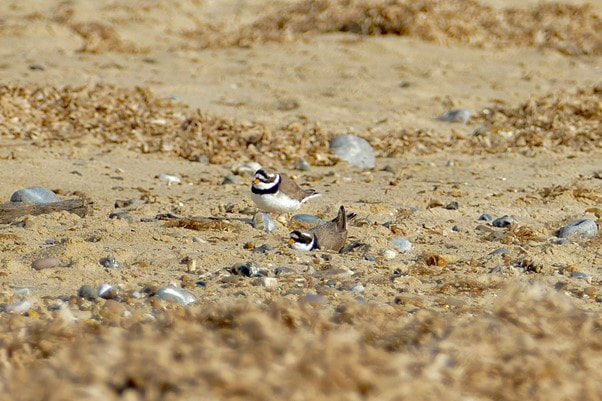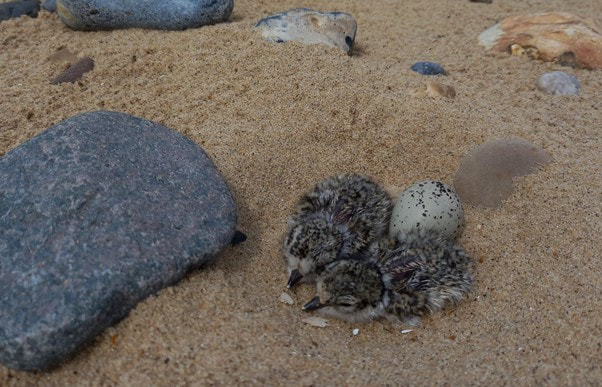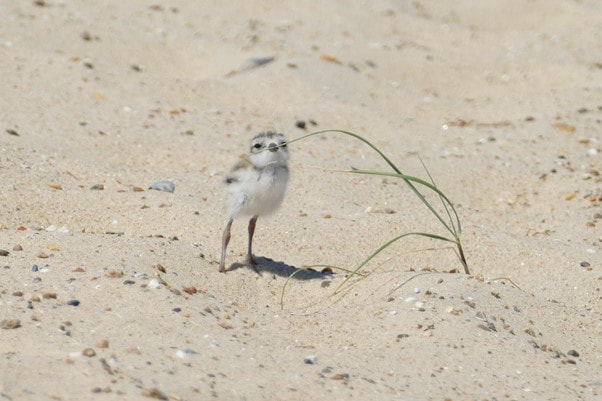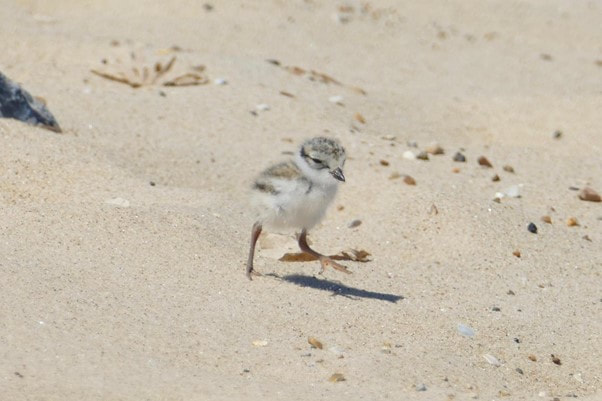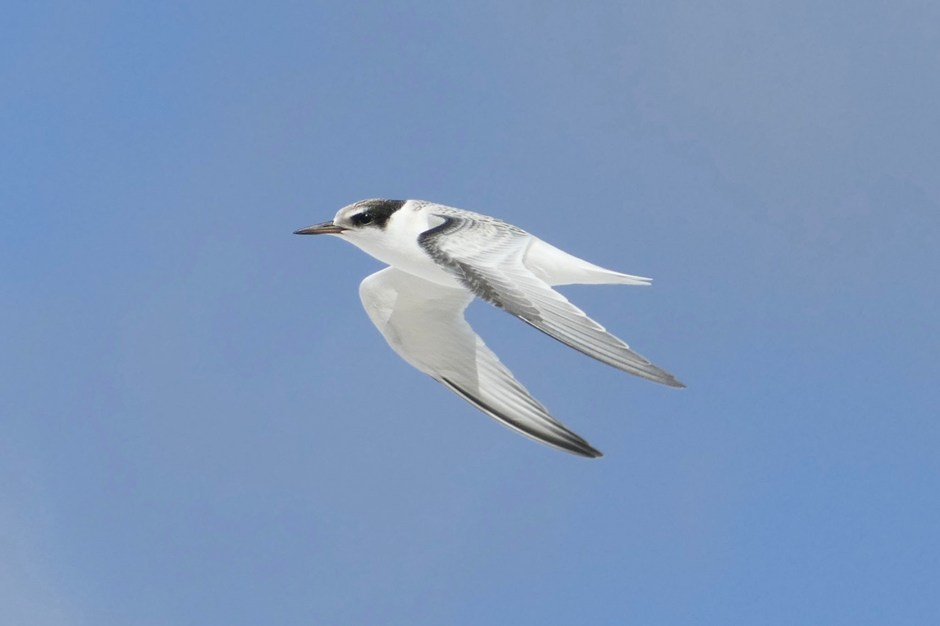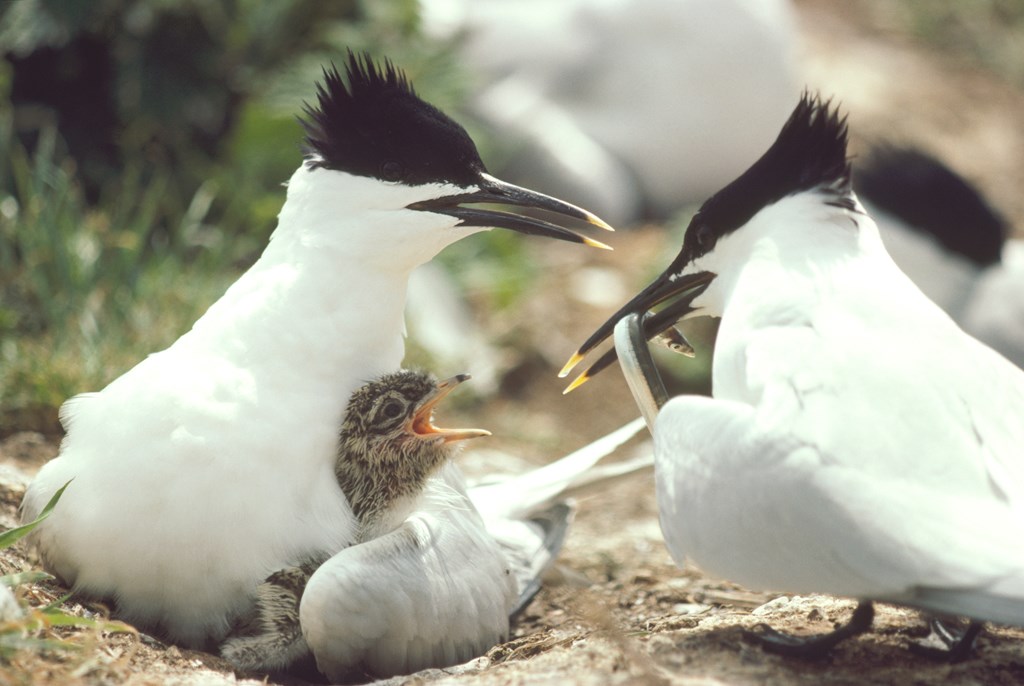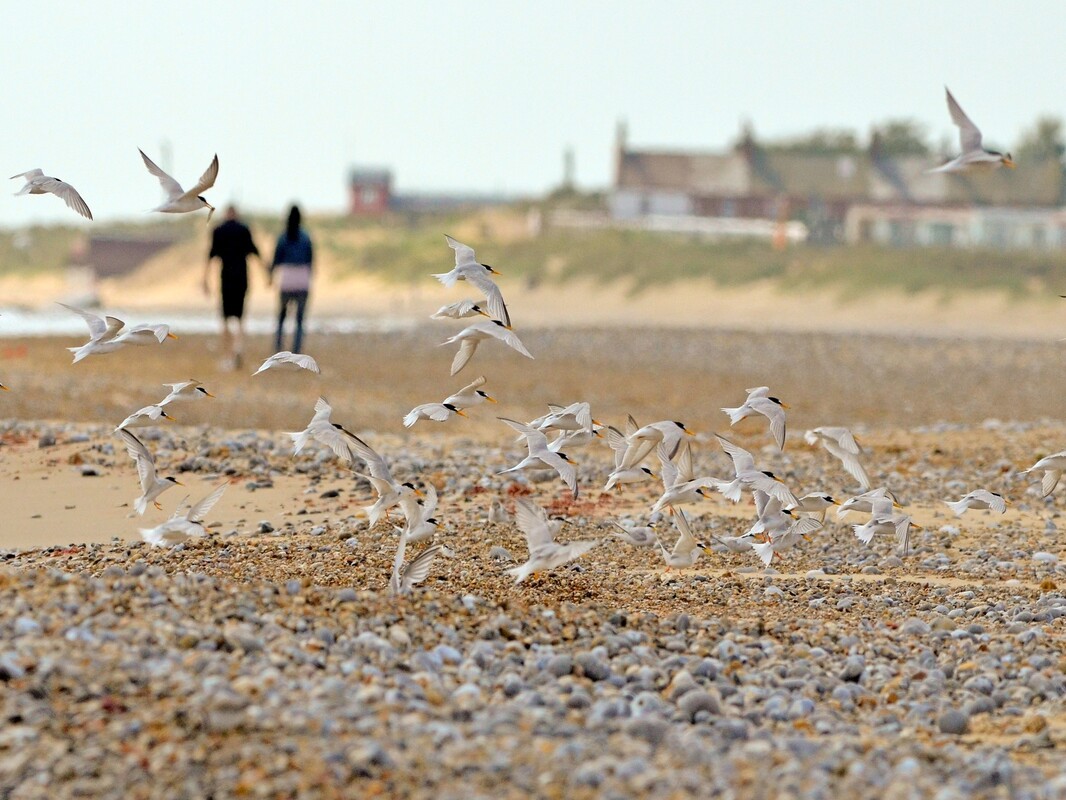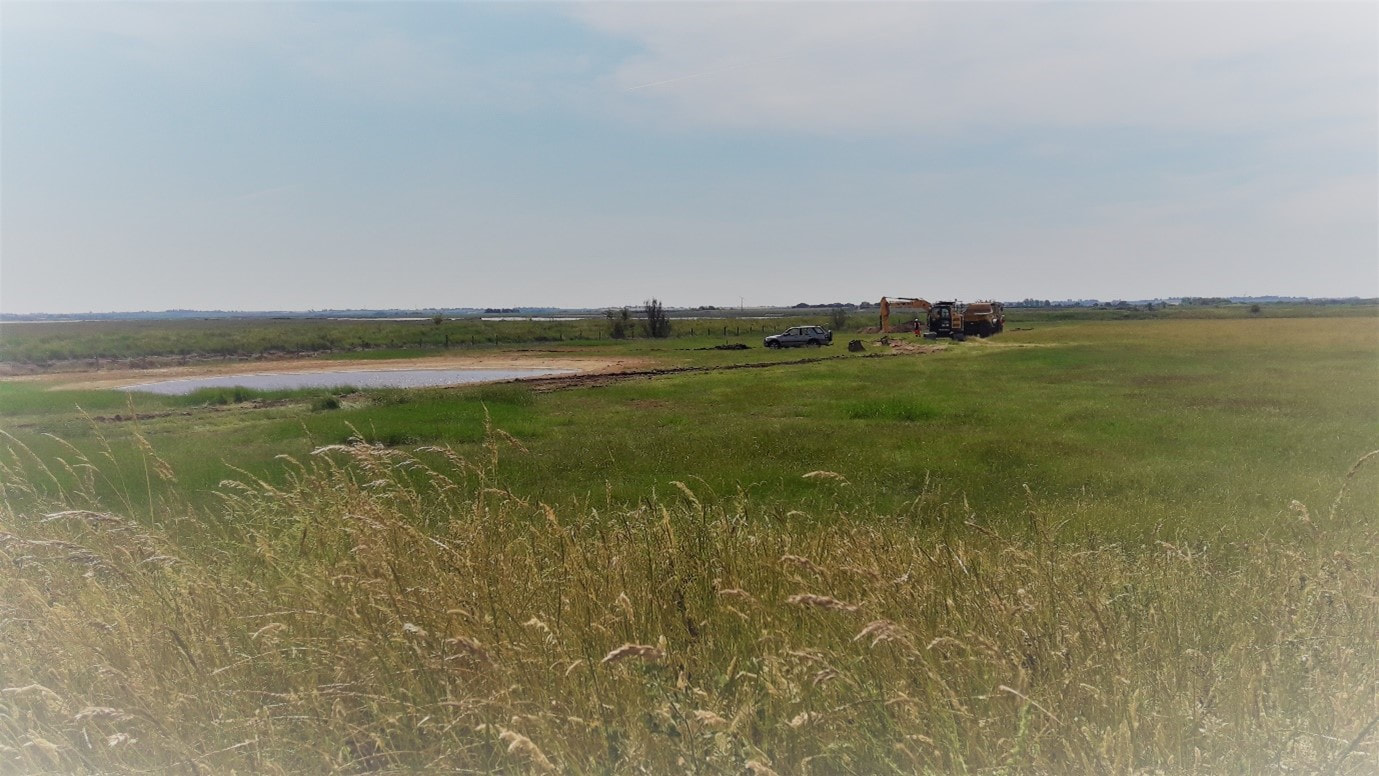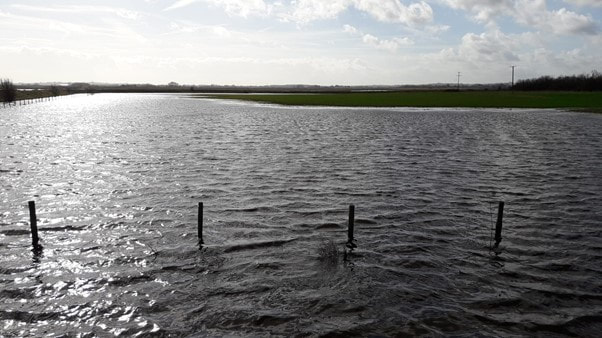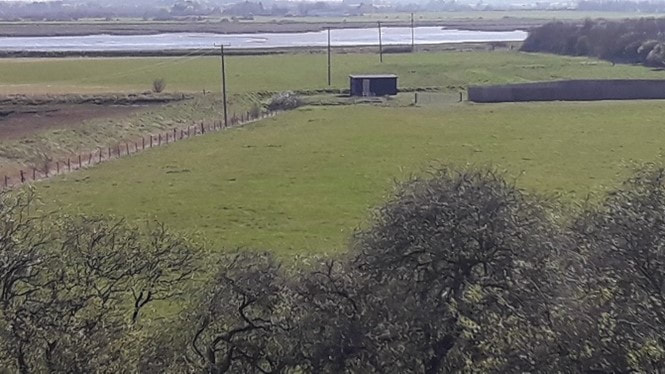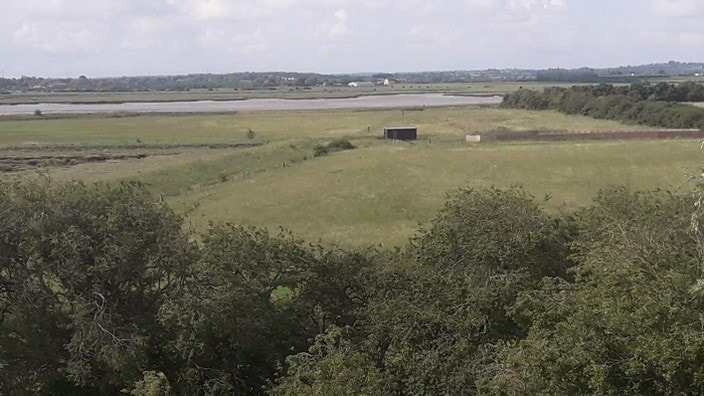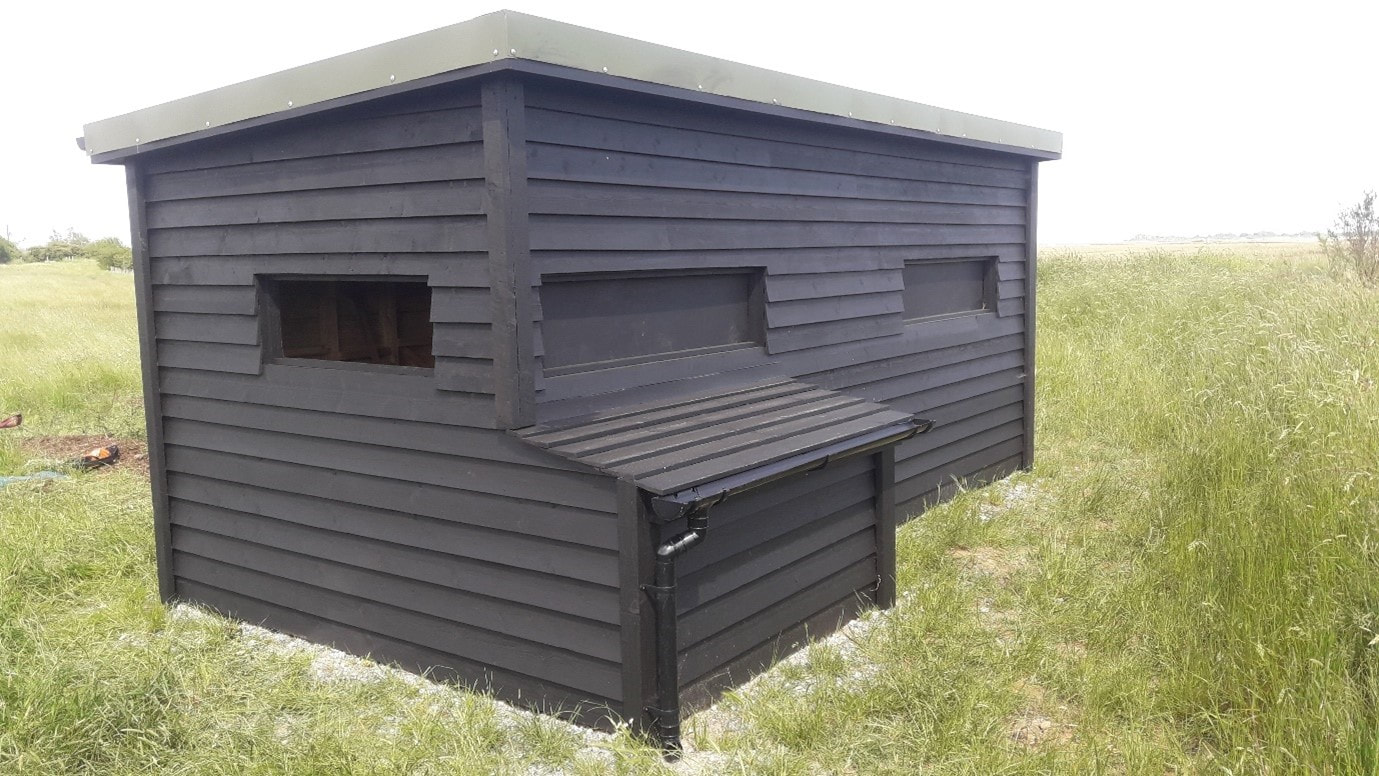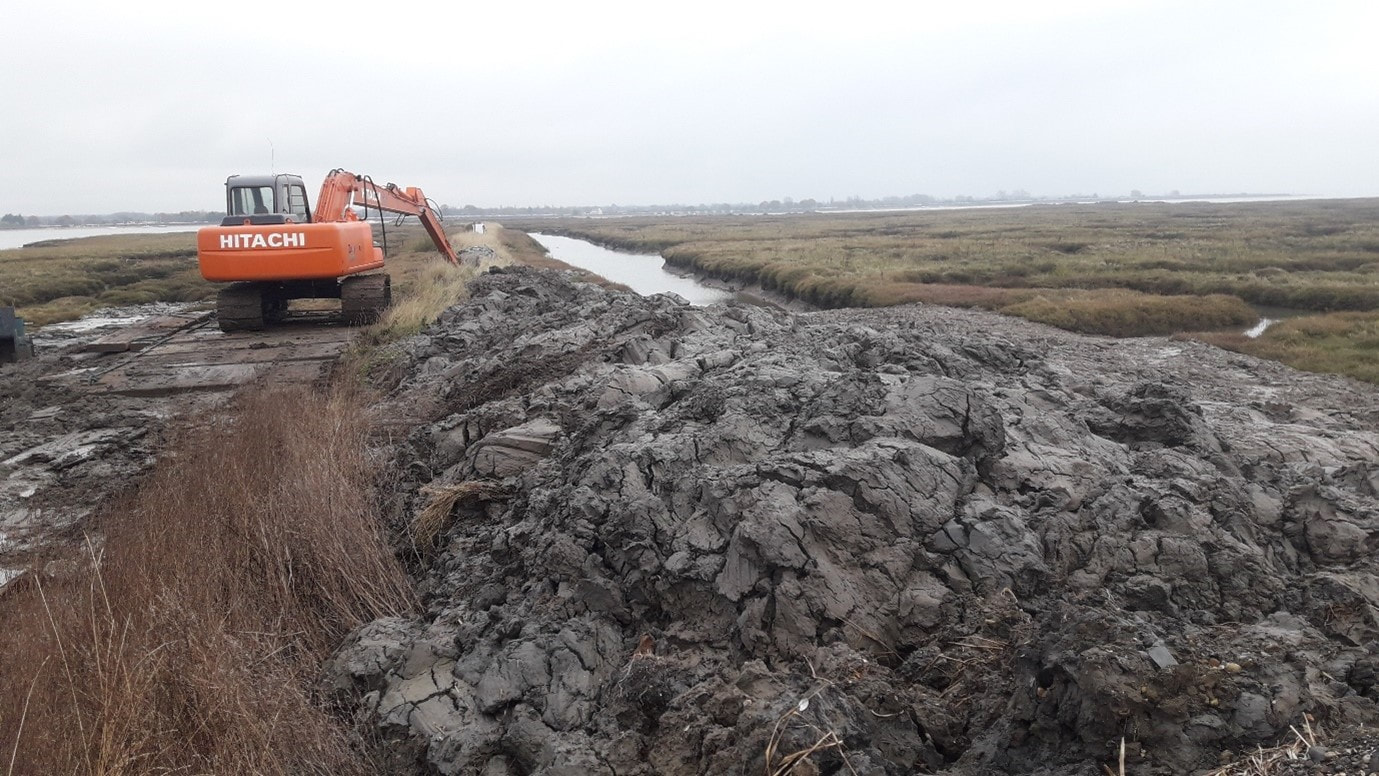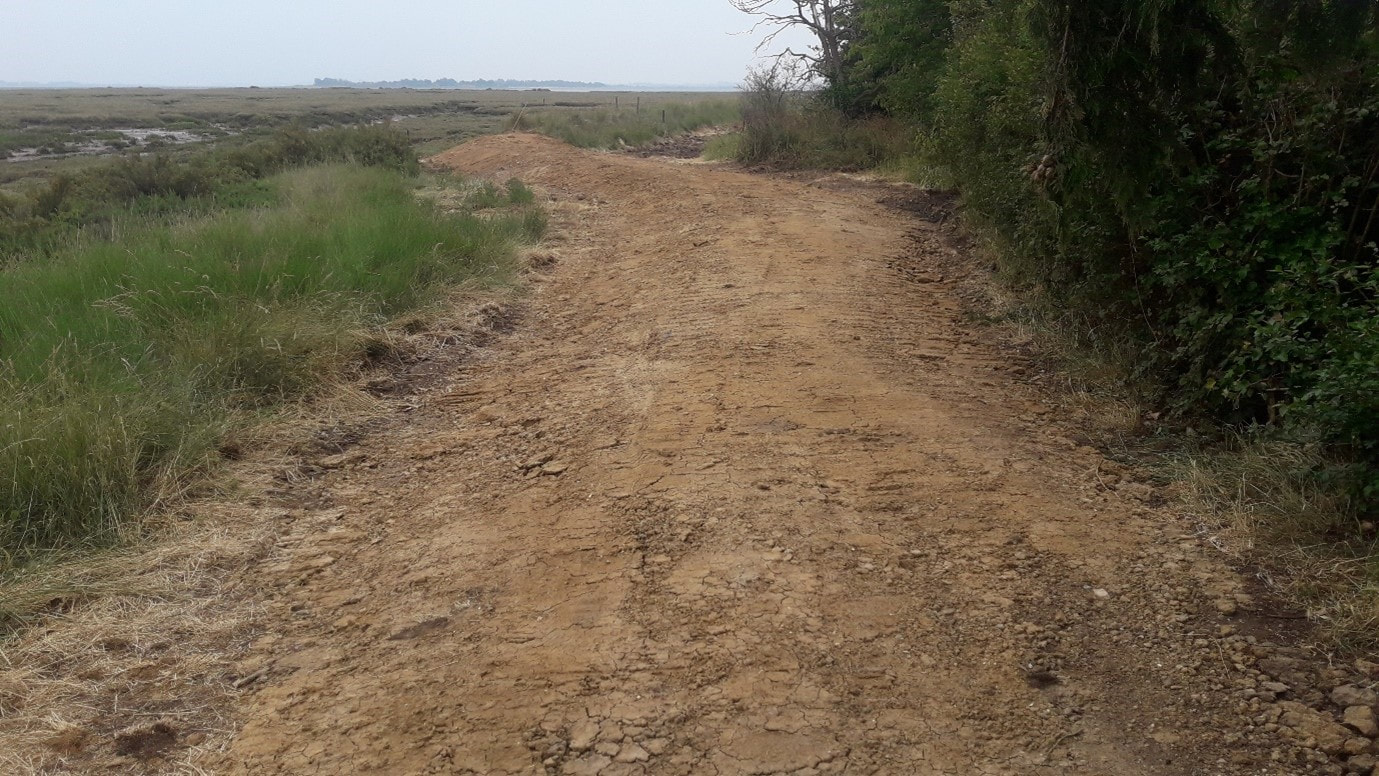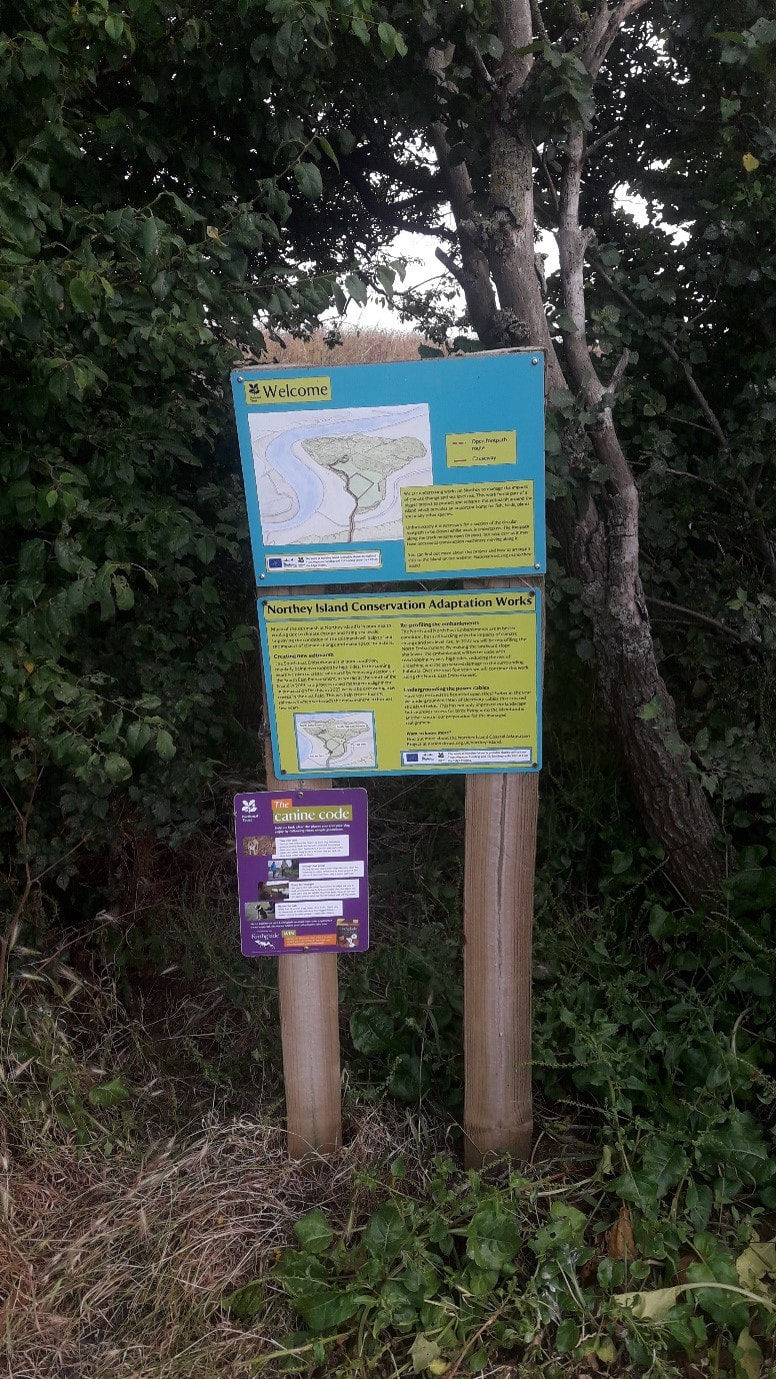|
By Will Bevan – Beach-Nesting Bird Field Officer in East Norfolk After spending last summer helping to protect the beach-nesting birds of East Norfolk, in April this year I was eagerly anticipating my return for another season. Being largely nocturnal in 2021, with my exploits as a night warden detailed on this blog, in 2022 I returned as a fully-fledged Field Officer. Our work covers three sites in East Norfolk and North Suffolk, with a team of dedicated volunteers and Field Officers working day and night over the breeding season to provide protection. Methods involve three sets of fencing (rope, electric, and poultry netting), signage, round the clock wardening, and public engagement and education on the beach and in the wider community. The focus is mainly on little terns, but this protection benefits other beach-nesting birds including ringed plovers, oystercatchers, and avocets. Little tern conservation is fraught with worry, as the odds seem to be stacked against them so heavily it is a wonder that any chicks fledge! Nesting in vulnerable spots on shingle beaches just above the tideline, they face numerous threats including human disturbance, dogs off leads, egg thieves, high tides and stormy weather (made worse by climate change), and predation from ground and aerial predators. Despite early disappointment last year with failures at two of our colony sites, mainly due to aerial predation pressure, the season ended up being a success overall with these failed birds moving to another site and re-laying, with around 137-216 fledglings leaving in mid-August. However, this was still just below the productivity target of 0.75 required to maintain or increase the population. This result also highlighted the importance of having several sites set up and ready to receive little terns which might fail elsewhere but have a second attempt at breeding in another location. With all this and stories from previous seasons in mind, it’s always a good idea not to raise hopes too high early in the season, as any number of things can go wrong. However, it was hard to not to be excited this year as the breeding got under way at the start of May. Whilst last year the terns took longer to prospect potential nest sites, eventually spreading out over all three of our protected colony areas, this year they settled in just one location. From our first egg being found on the 21st of May, just two weeks later we were counting around 300 active nests, making it the largest colony in the UK in 2022. This is compared to a peak count of 116 nests at the same site last year! The excitement started to spread as we realised that we might have a mega year on our hands. When managing several colonies there is always a difficult choice to be made because resources are limited, especially when it comes to the time of the volunteers and Field Officers. In many years the colony with the largest number of nests is prioritised as the one which receives the most protection, although a presence is still maintained at all sites. This is difficult because every breeding pair counts when it comes to little terns, with a potential for two or three fledglings which may live for two decades and have many more offspring over that lifespan. It was a relief this year to be able to put everything into one site, allowing us to have a more of a presence to deter predators and egg thieves, as well as to engage with the public on the beach. A cabin was brought down to the site for all our amenities, with solar powered lights for night shifts and a generator for charging equipment. This was a great place to get out of the weather, especially with the extreme heat we have had so far this year, as well as for observing the colony. From my experiences last year out at night in a tent, which flapped uneasily in the wind, the cabin made the night shifts almost luxurious in comparison. The first hatching date approached in mid-June with eager anticipation, as well as an increase in nerves. In previous years kestrels have been a large cause of mortality for younger chicks and fledglings, and on occasion decimated the colony. For example, a report from 2001 when the little terns nested at Great Yarmouth states that kestrels took a total of 526 chicks! Whilst we have been doing work on diversionary feeding to try and provide local kestrels with alternative food sources, a determined adult will continue to go after the terns despite our best efforts. The first tern chicks were sighted on the 14th of June and the weeks went by with only glimpses of kestrels, which luckily didn’t show interest in the colony. This did not stop the terns giving them hassle! A hobby started visiting regularly, trying to take adults and chicks, but the sheer number of little terns watching for predators and willing to mob them was enough to deter it on most occasions. This confidence lessened as the terns began to leave, and unfortunately for a few stragglers remaining towards the end of July, the hobby was much more successful. High spring tides can also be a challenge for the little terns, especially combined with strong north and easterly winds coming off the North Sea. Nests can be moved a small amount at a time, so long as we make sure to replicate the pattern of stones around the nest, but if the tide is high enough it can wipe out a large percentage of the colony. Luckily, we had no incidents where the nests were at risk this season, with the highest tides not coinciding with strong winds. Public engagement on the beach was also very positive this year, and this is a key part of our work in making people more aware of beach-nesting birds on the coast and educating them about responsible dog walking. I had some great conversations with those who knew about the birds already and many who were seeing them for the first time, and it was rewarding to be able to use scopes to allow adults and children to see the chicks up close. Dog owners were more than happy to put their pets on leads, showing that effective signage and friendly engagement can lead to positive behavioural changes. Little terns also need plentiful stocks of small fish in shallow water near to the colony, and this seemed to be no problem for them this year as they were constantly flying to and from the sea with fish for their growing young. It seemed like the stars aligned for this year’s season, and the full scale of what the terns had accomplished became apparent as the fledgling numbers built up on the shore. Our fledgling count was a whopping 585 on the 14th of July, and this is the lower estimate, with a potential for between 650- 700 leaving the site overall. This year was also productive for our ringed plovers, with a total of 17 nests and 18-25 fledged across our sites. Usually, plover nests are spread out along the coastline, but many choose to nest within our fencing as they are much less likely to be disturbed. For rogue pairs outside our main fence, we can put up some posts with a bit of rope and cross our fingers, and this year we had eggs successfully hatching from just such a nest! We also had two oystercatchers and three avocets fledge from our Suffolk site. Another joy of the season was watching a pair of plover chicks grow up into fledglings which had become habituated to our presence around the cabin, and on a night shift they often would run around my feet as I sat out in a camping chair! In a year when there has been lots of bad news, especially with bird flu and how it has affected our struggling bird populations, it is a relief to be able to share something positive. Although every year is different, we are all hoping that this is the beginning of a trend where we can start stabilising or even increasing the numbers on the East Coast and the U.K. Once again this has only been possible thanks to a truly incredible team of volunteers and staff, an extremely supportive local community, and the funding and support of Natural England and Great Yarmouth Borough Council.
3 Comments
Blog by Leigh Lock, RSPB Project Development Manager The global and national threats to seabirds are widely recognised and much focus understandably links the status of seabirds with the state of our seas which is where most seabirds spend most of their time. But what about the state of the ‘land’ where seabirds spend the breeding season – a critical phase of their lifecycle? As a land-based observer of birds on the coast for decades, the growing pressure on breeding seabird sites has been a major concern and I feel we have reached a tipping point where if we don’t act now there will be no safe nesting space left for seabirds in some areas in the future. Therefore, I was excited by the prospect of Seabird Conservation Strategies being developed within all four UK counties by government – each will set out the strategic needs of our seabird species and set out a route map for their recovery. This process in England has been led by DEFRA and NE. But I wanted to make sure that the current state of seabird colonies in England was reflected in this process and that the thoughts and concerns of those most close to the sites – the site managers, conservation officers etc responsible for these areas– were captured. So I contacted as many of those key people around the coast as possible to gather views on pressures impacting on seabird colonies. This is probably the first time such an assessment has been made. Much of this information gathered was necessarily subjective, being based on the opinions of the site managers, and others. However, expert judgement provided by the site managers most familiar with the sites, and their issues, constitutes the best available evidence on issues affecting England’s breeding seabirds. The process does present a ‘ground truthing’ to compare with other available data sources so that all the available information together can be used as ‘weight of evidence’ to identify the main issues and develop solutions to them. Working closely with colleagues within NE, we then looked to align this rather broad-brush assessment of pressures on colonies with other data sources being carried out to inform other areas of the strategy. Information was gathered on 222 natural sites (i.e., excluding urban gulls) and covering 24 seabird species – this representing the vast majority of England’s seabirds. Pressures were assigned to predefined categories including disturbance, habitat loss, predation, invasive species, disease, and control. Note that the assessments were carried out before the widespread and serious impacts of Avian Influenza (AI) were recorded in England in 2022. Overall, the most widespread was disturbance (see below), with both habitat loss and predation impacting on over 50% of the sites. The other pressures were recorded at far less sites, although their impacts at individual sites could be very significant (e.g., invasive species on islands). There are plenty of discussion points emerging from this but below I have pulled out just three. 1. The widespread impacts of disturbance Disturbance is the most widely reported pressure affecting England’s breeding seabirds impacting on 89% of the coastal sites, all sites supporting species like little tern and Sandwich tern, and 100% of English SPAs with breeding seabird features. Site managers see disturbance as THE rapidly growing issue, and human recreational disturbance at coastal sites is predicted to increase. Disturbance of nesting seabirds is caused by a range of recreational activities – beachgoers, dogwalkers and recreational fishers on land, and recreational watercraft such as jet skis, paddleboarders from the sea. Although disturbance is particularly an issue for ground-nesting birds such as terns and gulls at soft coast sites, I was also surprised how widely it was reported at cliff colonies and even offshore islands where birds vulnerable to disturbance from the sea. Disturbance at nest sites can have significant negative impacts on seabird breeding success through increased exposure of eggs and young to predation and the elements and can lead to the abandonment of nest sites and even entire colonies. What I see are overstretched, under resourced conservation organisations trying to manage coastal sites where nature conservation should be the priority, but recreational interests prevail. Many areas have wardens to ‘protect’ nesting birds and engage with the public. But without zonation policies and legislation to restrict certain activities, on-site teams of staff and volunteers face an uphill battle, and the birds using these sites face a bleak future. 2. Sea level rise and coastal erosion present an existential threat to some of England’s most important seabird colonies. Within England, most seabird sites occur on ‘soft coast’ sites – nearshore islands, salt marshes, lagoon islands and shingle banks. These habitats are under massive pressure and the reduction in size and quality of nesting habitat is the second most widespread pressure in England. Without intervention, 2,000 Ha of protected coastal habitats is predicted to be lost in England by 2060 with even greater areas being functionally lost as breeding habitat due to regular flooding. Previously, these losses were mainly from development and land claim, but the key future threats to coastal habitats are from climate change-related sea level rise, coastal erosion, and coastal squeeze. Mean sea levels in the UK have already risen by approximately 17 cm since the start of the 20th century and climate predictions show that they will continue to rise under all emissions scenarios until at least the year 2100. Increases in sea level rise are difficult to predict but are likely to be greatest in southern and eastern England where some of the largest colonies are. Rising sea levels mean that more coastal seabird breeding habitat will be lost, and the risk of intermittent flooding of nest sites is also increased. In addition to mean sea level rise, the risks of extreme sea levels and flooding are compounded by increases in storm events. Species that nest on the ground in sand and shingle habitats, such as terns and gulls, are particularly at risk, as large areas of these types of habitats can be lost rapidly with only minor increases in sea level. Many current breeding sites for terns and gulls on beaches and low-lying near-shore islands which are likely to become unsuitable or be lost entirely within the next 10 years. Little terns are particularly at risk because they tend to nest just above the high-water mark and in recent years high proportions of the UK’s little tern nests have been flooded out during spring tides and storm surges. Short term fixes are in place at many sites. Habitat management to keep sites open, recharge of shingle islands to raise their levels above highest tides but longer-term measures are required to ensure that seabirds have safe nesting sites for future decades not just the next few years. This involves factoring seabird breeding habitat into multi-stakeholder strategic management planning eg Shoreline Management Plans (SMPs), Nature Recovery Networks (NRNs), Local Nature Recovery Strategies (LNRS)) and the implementation of the government’s 25-year Environment Plan. Breeding seabirds should be considered in full as part of these overarching plans and programmes, to ensure that existing breeding sites are adequately managed, and new breeding habitat is created and maintained, and linked to funding streams like Biodiversity Net Gain. 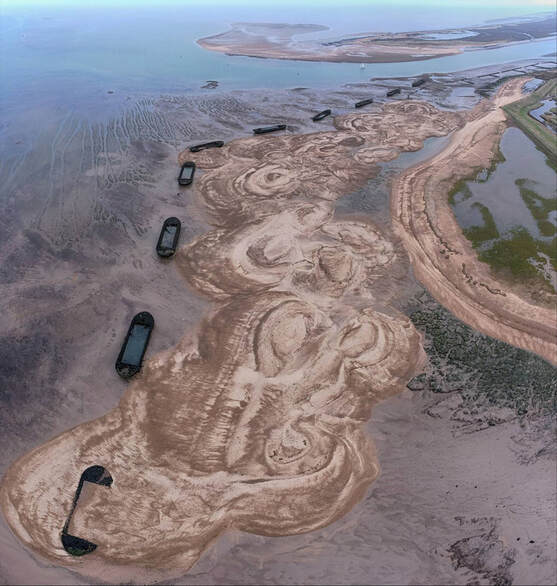 Beneficial use of dredged sediment can be used more widely to provide habitat for nesting seabirds and provide natural sea defences – here 50,000 cubic metres of sediment delivered through @ProjectLOTE working with Harwich Haven Authority, EA and the landowner supports the most important little tern colony in Essex (c) JPullen 3. Avian Influenza and the in-combination effects.
As mentioned above, the assessment was carried out last year before the impacts of AI were recorded in England this summer. Disease was not noted as a significant pressure and has not really impacted on seabirds since botulism on gulls in the past. But the impacts of AI in 2022 have been severe – impacting significantly on the largest UK and England colonies of both roseate and sandwich terns – Coquet and Scolt Head Islands respectively -with 1000s of dead breeding adults and large-scale breeding failure at these colonies. we await a full assessment of the impact of AI on seabirds in 2022 and how it might impact in the future. But think of the conditions under which AI was able to make such an impact. The ‘in combination’ effects of habitat loss, predation, disturbance have pushed seabirds to the edge – habitat loss squeezing seabirds into fewer and fewer suitable areas, which then become honey pots for predators, and even these few special sites coming under the unbearable pressure of disturbance. All our eggs in fewer and fewer baskets. And then a disease comes along which thrives in conditions where it can spread rapidly amongst individuals in closely packed colonies. To have seabird populations that can be resilient to AI and other diseases, we need more space for them to nest safely, allowing more colonies to thrive, and allowing more mobility from site to site to respond to changes in local conditions. Building resilience to disease and other pressures, requires spreading the risk – more and bigger sites, better managed. For this we need to rethink how our coast is managed. The report The full report is on the documents page of this website. Lock, L., Donato, B., Jones, R., Macleod-Nolan, C. 2022 England’s breeding seabirds: A review of the status of their breeding sites and suggested measures for their recovery. RSPB and Natural England report. The report highlights the most important sites and actions for the recovery of seabirds in England. The recommendations from this report on site management have been incorporated into a wider set of recommendations covering the full suite of seabird ecology -under four categories -breeding, feeding, surviving and knowledge. These recommendations have been made by NE to DEFRA to inform the further development of the England Seabird Conservation Strategy and the implementation of the 25 Year Plan. The Strategy should be available early in 2023. Through ProjectLOTE we will continue to advocate for these changes and work with stakeholders all-round the coast to deliver what we can to help seabirds. Final thoughts There are probably few more committed and enthusiastic workers than those managing seabird colonies and they are doing a brilliant job holding the line against growing pressures from all directions. But they need help. For all the above reasons, the England Seabird Conservation Strategy couldn’t come at a better time, and we must all hope that it brings a step change in the priority and resources allocated to management of seabird colonies in England. Over to you DEFRA. Thanks to all those who contributed information towards this assessment. Good luck to all of you with your challenges ahead. Blog by David Mason, National Trust Suffolk and Essex Coast Ranger for Northey Island Much of the saltmarsh at Northey Island is in poor health, eroding due to climate change and rising sea levels. Improving the condition of the saltmarsh will help to limit the impacts of climate change and make space for nature to thrive. Creating new saltmarsh The South East Embankment is in poor condition, regularly being overtopped by high tides. In the coming years we plan to create new saltmarsh by removing sections of this embankment, as we did at the south of the island in 2019, in a process called managed realignment. In preparation for this, in 2022 we are excavating new creeks in the East Field. This will help create healthy saltmarsh when we breach the embankment in the next few years by bringing silt and seed into the former field and allowing it to deposit and build up along the banks. On the face of it creating saltmarsh might appear simple. Remove the sea walls to let in the tide and allow the tide and natural processes to deposit silt and seeds to grow new habitat. This however is only the visible part of it. Species and habitat monitoring and satisfying the regulatory bodies; translocation of protected species and creation of compensatory habitat; gaining funding from internal and external national and international funding bodies and reporting to them; analysis of the expected natural processes, careful design of the new infrastructure and navigating the marine regulatory process; moving existing infrastructure; ongoing monitoring to measure the effects of the changes; managing contractors, staff and volunteers; and explaining it all to members of the public and colleagues: all these factors and more go into Saltmarsh protection and re-creation. This video gives an overview of the site and project aims. In February a surge tide came over the South East Embankment and flooded part of the island. This demonstrates why we need to consider how we manage Northey Island in the face of sea level rise and climate change. The overtopping of the embankments is not uncommon, happening at least annually and the frequency will increase into the future. The area of water gives a rough idea of where the tide will come to when the embankment is realigned. As sea levels rise further the new saltmarsh will progress even further onto the land. The water has now receded but is a reminder of why we continue to do our work at Northey Island. Removing overhead powerlines. Since the last blog there have been a few changes on site. Perhaps the biggest is the removal of the power lines that crossed the fields and the burying of new cables to the houses. Some of these power poles were in areas that will become saltmarsh. This has made a great difference to the landscape and will allow more safe access for birds flying into the fields, including the Brent Geese that come in during the winter to roost and feed. We have left some poles in place, cut down in height, and plan to install nesting boxes to the tops of the poles in the hope of enticing oystercatchers and other estuary birds to breed here. Volunteers As small cogs in that project machine at Northey Island, the volunteers and I have been supporting this work. The Essex and Suffolk National Trust Volunteers helped to paint the new hide which looks out over this area. They also weeded and mulched new hedging, watered new plants around the pond in the dry weather in early spring and cleared up a large amount of litter from the foreshore, including the flotsam and jetsam brought onto the island by the surge tide. They have also helped to prepare the ground for a new footpath through the fields to the hide. Wildlife Marsh harriers are regularly seen over the saltmarsh and a variety of birds have been using the area around the new scrape near the hide including yellow wagtail, shelduck, snipe, little egret, curlew, lapwing, teal, mallard, and shoveler. Cuckoos and whitethroat can be heard through the summer and Brent geese roost on the grass fields during the winter. Hopefully there will be plenty to see, looking over the developing saltmarsh, when the hide is open to the public. The hedges and grassland are alive with butterflies and walking along the access road in June and July surrounded by clouds of Meadow Browns feeding on the privet is mesmerising. A new freshwater pond has been created near the hide which will provide a more stable and favourable home for the water voles that currently reside in an unsustainable area. Once new pond side vegetation is fully established the plan is to translocate the voles to their new home. Diving beetles, water boatmen, pond skaters and dragonflies are already colonising these areas. Improved resilience to change Further locally dredged sediment has also been placed in the north-west of the island to raise up the saltmarsh. This will protect saltmarsh in this area, avoiding new channels being formed and reducing higher water flows over the saltmarsh which cause erosion and vegetation loss. This work has allowed further sediment to be deposited in the saltmarsh by the tides, building up the marsh and allowing saltmarsh plants to regenerate. This is improving diversity and creating rare upper saltmarsh where the marsh transitions into the terrestrial land. A section of bank has been reinstated at the north of the Island which has a shallower profile that will be better able to cope with overtopping by high tides, allowing water to run off without damaging the bank. This will help to protect the north of the island as sea levels rise. Topsoil will be spread to allow it to revegetate quickly. Public engagement. While patrolling the site and talking to visitors, answering email enquiries, and even commissioning the signs from the printer, explaining the aims and progress of the project to visitors and the local community is an important part of my role. The project featured in the National Trust member’s magazine reaching more than 5 million members. The Northey Island website has also been updated with project developments. https://www.nationaltrust.org.uk/northey-island |
Archives
April 2024
Categories
All
Photo credits: Oystercatcher by Katie Nethercoat (rspb-images.com)
LOTE Logo credits: Saskia Wischnewski |

